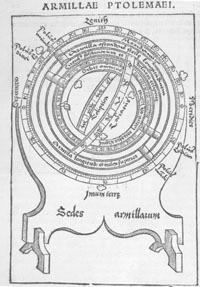Ptolemy and the Armillary Sphere
The
armillary sphere, or spherical astrolabe, was the most complex of the instruments that
Ptolemy described in the
Syntaxis, comprising seven interlocking, graduated rings, representing the fundamental circles of the heavens, that swivelled around various axes within a skeletal sphere. It was designed to permit direct reading of the position of a celestial body in convenient co-ordinates.
As demonstration instruments, used in teaching the concepts of astronomy, armillary spheres endured long after the Middle Ages and survived the overthrow of the Ptolemaic system itself. As practical instruments, at least as described by Ptolemy, their use was limited; for accurate results a very skilled observer was required to align all the rings correctly before making an observation.
Recommended Reading
M.Hoskin (ed.)
The Cambridge Illustrated History of Astronomy, Cambridge 1997
J.North The Fontana History of Astronomy and Cosmology, London 1994
G.J.Toomer "Ptolemy", pp.186-206 in The Dictionary of Scientific Biography, New York 1970
Full Bibliography
 The armillary sphere image from Schöner's edition of Regiomontanus's description.
The armillary sphere image from Schöner's edition of Regiomontanus's description.